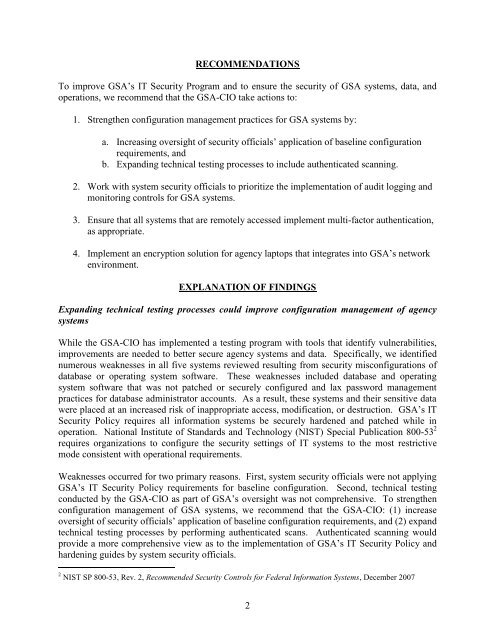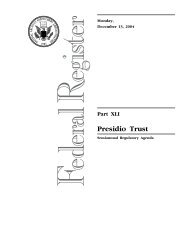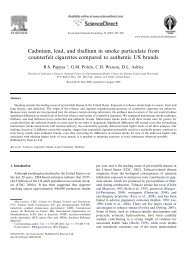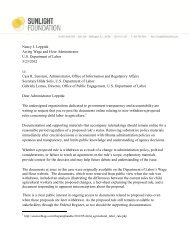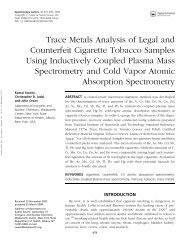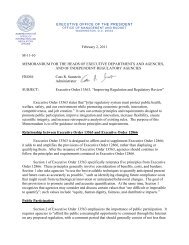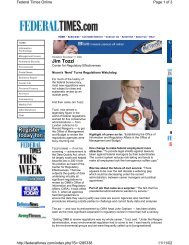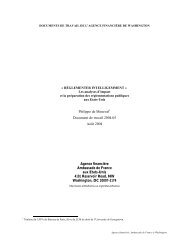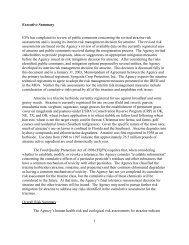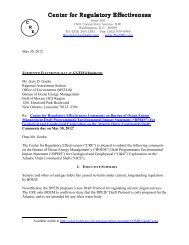FY 2010 Office of Inspector General
FY 2010 Office of Inspector General
FY 2010 Office of Inspector General
Create successful ePaper yourself
Turn your PDF publications into a flip-book with our unique Google optimized e-Paper software.
RECOMMENDATIONS<br />
To improve GSA’s IT Security Program and to ensure the security <strong>of</strong> GSA systems, data, and<br />
operations, we recommend that the GSA-CIO take actions to:<br />
1. Strengthen configuration management practices for GSA systems by:<br />
a. Increasing oversight <strong>of</strong> security <strong>of</strong>ficials’ application <strong>of</strong> baseline configuration<br />
requirements, and<br />
b. Expanding technical testing processes to include authenticated scanning.<br />
2. Work with system security <strong>of</strong>ficials to prioritize the implementation <strong>of</strong> audit logging and<br />
monitoring controls for GSA systems.<br />
3. Ensure that all systems that are remotely accessed implement multi-factor authentication,<br />
as appropriate.<br />
4. Implement an encryption solution for agency laptops that integrates into GSA’s network<br />
environment.<br />
EXPLANATION OF FINDINGS<br />
Expanding technical testing processes could improve configuration management <strong>of</strong> agency<br />
systems<br />
While the GSA-CIO has implemented a testing program with tools that identify vulnerabilities,<br />
improvements are needed to better secure agency systems and data. Specifically, we identified<br />
numerous weaknesses in all five systems reviewed resulting from security misconfigurations <strong>of</strong><br />
database or operating system s<strong>of</strong>tware. These weaknesses included database and operating<br />
system s<strong>of</strong>tware that was not patched or securely configured and lax password management<br />
practices for database administrator accounts. As a result, these systems and their sensitive data<br />
were placed at an increased risk <strong>of</strong> inappropriate access, modification, or destruction. GSA’s IT<br />
Security Policy requires all information systems be securely hardened and patched while in<br />
operation. National Institute <strong>of</strong> Standards and Technology (NIST) Special Publication 800-53 2<br />
requires organizations to configure the security settings <strong>of</strong> IT systems to the most restrictive<br />
mode consistent with operational requirements.<br />
Weaknesses occurred for two primary reasons. First, system security <strong>of</strong>ficials were not applying<br />
GSA’s IT Security Policy requirements for baseline configuration. Second, technical testing<br />
conducted by the GSA-CIO as part <strong>of</strong> GSA’s oversight was not comprehensive. To strengthen<br />
configuration management <strong>of</strong> GSA systems, we recommend that the GSA-CIO: (1) increase<br />
oversight <strong>of</strong> security <strong>of</strong>ficials’ application <strong>of</strong> baseline configuration requirements, and (2) expand<br />
technical testing processes by performing authenticated scans. Authenticated scanning would<br />
provide a more comprehensive view as to the implementation <strong>of</strong> GSA’s IT Security Policy and<br />
hardening guides by system security <strong>of</strong>ficials.<br />
2 NIST SP 800-53, Rev. 2, Recommended Security Controls for Federal Information Systems, December 2007<br />
2


